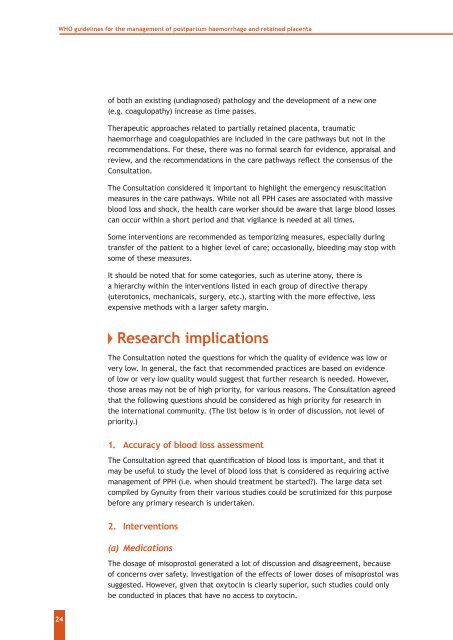WHO guidelines for the management of postpartum haemorrhage ...
WHO guidelines for the management of postpartum haemorrhage ...
WHO guidelines for the management of postpartum haemorrhage ...
Create successful ePaper yourself
Turn your PDF publications into a flip-book with our unique Google optimized e-Paper software.
<strong>WHO</strong> <strong>guidelines</strong> <strong>for</strong> <strong>the</strong> <strong>management</strong> <strong>of</strong> <strong>postpartum</strong> <strong>haemorrhage</strong> and retained placenta<br />
<strong>of</strong> both an existing (undiagnosed) pathology and <strong>the</strong> development <strong>of</strong> a new one<br />
(e.g. coagulopathy) increase as time passes.<br />
Therapeutic approaches related to partially retained placenta, traumatic<br />
<strong>haemorrhage</strong> and coagulopathies are included in <strong>the</strong> care pathways but not in <strong>the</strong><br />
recommendations. For <strong>the</strong>se, <strong>the</strong>re was no <strong>for</strong>mal search <strong>for</strong> evidence, appraisal and<br />
review, and <strong>the</strong> recommendations in <strong>the</strong> care pathways reflect <strong>the</strong> consensus <strong>of</strong> <strong>the</strong><br />
Consultation.<br />
The Consultation considered it important to highlight <strong>the</strong> emergency resuscitation<br />
measures in <strong>the</strong> care pathways. While not all PPH cases are associated with massive<br />
blood loss and shock, <strong>the</strong> health care worker should be aware that large blood losses<br />
can occur within a short period and that vigilance is needed at all times.<br />
Some interventions are recommended as temporizing measures, especially during<br />
transfer <strong>of</strong> <strong>the</strong> patient to a higher level <strong>of</strong> care; occasionally, bleeding may stop with<br />
some <strong>of</strong> <strong>the</strong>se measures.<br />
It should be noted that <strong>for</strong> some categories, such as uterine atony, <strong>the</strong>re is<br />
a hierarchy within <strong>the</strong> interventions listed in each group <strong>of</strong> directive <strong>the</strong>rapy<br />
(uterotonics, mechanicals, surgery, etc.), starting with <strong>the</strong> more effective, less<br />
expensive methods with a larger safety margin.<br />
Research implications<br />
The Consultation noted <strong>the</strong> questions <strong>for</strong> which <strong>the</strong> quality <strong>of</strong> evidence was low or<br />
very low. In general, <strong>the</strong> fact that recommended practices are based on evidence<br />
<strong>of</strong> low or very low quality would suggest that fur<strong>the</strong>r research is needed. However,<br />
those areas may not be <strong>of</strong> high priority, <strong>for</strong> various reasons. The Consultation agreed<br />
that <strong>the</strong> following questions should be considered as high priority <strong>for</strong> research in<br />
<strong>the</strong> international community. (The list below is in order <strong>of</strong> discussion, not level <strong>of</strong><br />
priority.)<br />
1. Accuracy <strong>of</strong> blood loss assessment<br />
The Consultation agreed that quantification <strong>of</strong> blood loss is important, and that it<br />
may be useful to study <strong>the</strong> level <strong>of</strong> blood loss that is considered as requiring active<br />
<strong>management</strong> <strong>of</strong> PPH (i.e. when should treatment be started?). The large data set<br />
compiled by Gynuity from <strong>the</strong>ir various studies could be scrutinized <strong>for</strong> this purpose<br />
be<strong>for</strong>e any primary research is undertaken.<br />
2. Interventions<br />
(a) Medications<br />
The dosage <strong>of</strong> misoprostol generated a lot <strong>of</strong> discussion and disagreement, because<br />
<strong>of</strong> concerns over safety. Investigation <strong>of</strong> <strong>the</strong> effects <strong>of</strong> lower doses <strong>of</strong> misoprostol was<br />
suggested. However, given that oxytocin is clearly superior, such studies could only<br />
be conducted in places that have no access to oxytocin.<br />
24
















